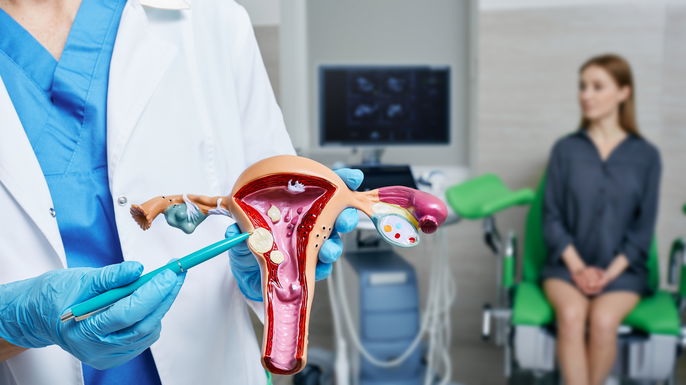An intramural fibroid is a type of benign tumor that grows within the muscular wall of the uterus, called myometrium. In most cases, it is caused by changes in hormonal levels, mainly estrogen, which leads to the overgrowth of cells in the uterine muscular tissue.
Intramural fibroids do not always cause symptoms and are often found during routine gynecological examinations. However, some women may present with symptoms such as abdominal pain, increased menstrual flow and infertility, especially when the fibroid increases in size or if several myomas are present.
If you notice symptoms of an intramural fibroids, you should consult a gynecologist for diagnosis and, if necessary, the most appropriate treatment can be initiated. This may involve surgical removal or medication to manage symptoms and prevent further growth.

Common symptoms
The main symptoms of intramural fibroids are:
- Lower abdominal pain
- Increased abdominal volume
- Abnormal menstrual bleeding
- Constipation
- Difficulty urinating
- Bleeding outside of the menstrual period, however, is not as common in this type of fibroid.
These symptoms are more likely to appear when multiple intramural fibroids are present, or when the fibroid increases in size. In most cases, an intramural fibroid does not cause any symptoms and is found through routine imaging tests.
Therefore, if you notice symptoms that are indicative of an intramural fibroid, you should consult a gynecologist for testing and treatment as needed.
Can intramural fibroids make pregnancy difficult?
Intramural fibroids usually do not interfere with fertility or getting pregnant. However, very large fibroids can cause changes in the shape of the uterus, as well as abnormalities in circulation. They can also give rise to inflammation, which can make embryo implantation and pregnancy more difficulty.
Women with an intramural fibroid can become pregnant and have a normal pregnancy, however, very large fibroids that cause symptoms can also interfere with fetal development. Therefore, women who have fibroids and are planning to become pregnant should see a gynecologist for assessment.
Confirming a diagnosis
A diagnosis of intramural fibroids is confirmed by a gynecologist and starts with an assessment of the patient's symptoms and health history. The doctor will perform a gynecological exams and order blood tests, such as beta-HCG (to rule out pregnancy), complete blood count, TSH and prolactin. The results of these tests can help to rule out other conditions that present with similar symptoms, such as uterine polyps, adenomyosis or leiomyosarcoma, for example.
The doctor will also order imaging tests, such as a transvaginal or pelvic ultrasound, MRI or diagnostic hysteroscopy, to assess the size, quantity and shape of the fibroid/s and to confirm the diagnosis.
Possible causes
The exact cause of intramural fibroids is not yet fully known, however, some factors may contribute to its development, such as:
- Hormonal changes, especially high estrogen levels
- Early onset of menstruation, before the age of 12
- Late menopause
- Never having been pregnant
- Obesity
- Family history of uterine fibroids
Other factors that can increase the risk of developing this type of fibroid include a diet that is rich in red meat and low in vegetables, and excessive alcohol intake.
Although intramural fibroids are the most common type of fibroids, other places that tumors can develop include the inner lining of the uterus, called submucosal fibroids, or in its outermost part, called subserosal fibroids.
Treatment options
Treatment for intramural fibroids is not always necessary. Small, asymptomatic fibroid may only be monitored by a gynecologist, with gynecological exams and tests ordered periodically to evaluate for any growth or new symptoms.
However, intense symptoms of intramural fibroids may require treatment such as:
- Anti-inflammatory medicines, such as ibuprofen or naproxen, to relieve abdominal pain and reduce excessive bleeding
- Combined or progesterone-only oral contraceptives to help alleviate the intensity of menstruation and reduce the size of the fibroid
- Gonadotropin-releasing hormone (GnRH) agonists, which help inhibit the production of estrogen and progesterone, preventing women from menstruating and reducing the size of fibroids;
- Hormonal IUD, such as Mirena, which helps reduce the size of intramural fibroids;
- Myomectomy, which is surgery to remove the fibroid, without having to remove the uterus.
- Hysterectomy, which is another type of surgery that removes the entire uterus, preventing complications from myoma.
Other treatment options include surgical procedures like embolization or occlusion of the uterine artery, which reduce blood supply to the uterus and fibroids. These can help relieve the symptoms like heavy bleeding, and is normally indicated for women who they want to preserve fertility.






























